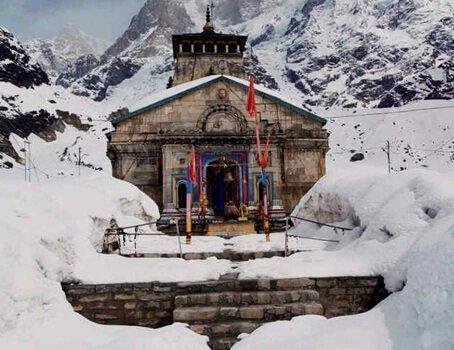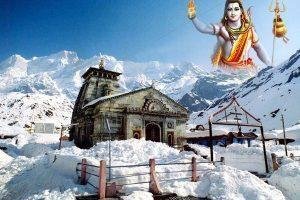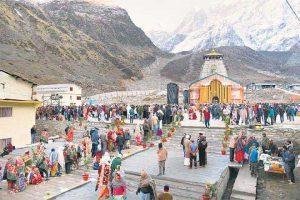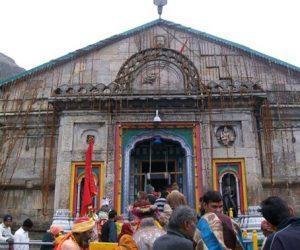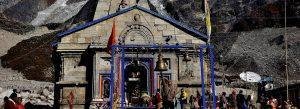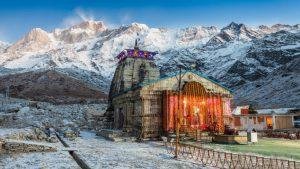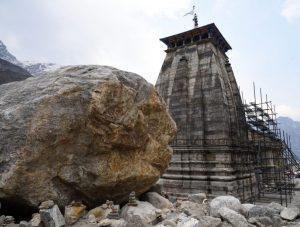Kedarnath Temple, Rudraprayag, Uttarakhand
| Date built: | – |
|---|---|
| Deity: | Kedarnath, ‘Lord of Kedar Khand’ (Shiva) |
| Architectural style: | – |
| Major festivals | – |
| Locale: | Kedarnath |
| District:: | Rudraprayag |
| Address: | – |
| Phone | – |
Kēdārnāth Mandir (Kedarnath Temple) is a Hindu temple dedicated to Lord Shiva. It is on the Garhwal Himalayan range near the Mandakini river in Kedarnath, Uttarakhand in India. Due to extreme weather conditions, the temple is open only between the end of April (Akshaya Tritriya) to November (Kartik Purnima – the autumn full moon). During the winters, the vigrahas (deities) from Kedarnath temple are brought to Ukhimath and worshipped there for six months. Lord Shiva is worshipped as Kedarnath, the ‘Lord of Kedar Khand’, the historical name of the region.
The temple is not directly accessible by road and has to be reached by a 18 kilometres (11 mi) uphill trek from Gaurikund. Pony and manchan service is available to reach the structure. According to Hindu legends, the temple was initially built by Pandavas, and is one of the twelve Jyotirlingas, the holiest Hindu shrines of Shiva . It is one of the 275 Paadal Petra Sthalams, expounded in Tevaram. Pandavas were supposed to have pleased Shiva by doing penance in Kedarnath . The temple is one of the four major sites in India’s Chota Char Dham pilgrimage of Northern Himalayas. This temple is the highest among the 12 Jyotirlingas.Kedarnath was the worst affected area during the 2013 flash floods in North India. The temple complex, surrounding areas and Kedarnath town suffered extensive damage, but the temple structure did not suffer any “major” damage, apart from a few cracks on one side of the four walls which was caused by the flowing debris from the higher mountains. A large rock among the debris acted as a barrier, protecting the temple from the flood. The surrounding premises and other buildings in market area were heavily damaged.
Architecture
Legend / Local stories
The temple, at a height of 3,583 m (11,755 ft), 223 km from Rishikesh, on the shores of Mandakini river, a tributary of Ganga, is a stone edifice of unknown date.It is not certain who built the original Kedarnath temple and when. The name “Kedarnath” means “the lord of the field”: it derives from the Sanskrit words kedara (“field”) and natha (“lord”). The text Kashi Kedara Mahatmya states that it is so called because “the crop of liberation” grows here. According to a mythological account, the god Shiva agreed to dwell here at the request of Nara-Narayana.[9] After the Kurukshetra War, the Pandava brothers, came here to meet Shiva on the advice of the sage Vyasa, because they wanted to seek forgiveness for killing their kin during the war. However, Shiva did not want to forgive them: so, he turned into a bull and hid among the cattle on the hill. When the Pandavas managed to track him, he tried to disappear by sinking himself head-first into the ground. One of the brothers grabbed his tail, forcing him to appear before them and forgive them. The Pandava brothers then built the first temple at Kedarnath. The portions of Shiva’s body later appeared at four other locations; and collectively, these five places came to be known as the five Kedaras (“Panch Kedar”); the head of the bull appeared at the location of the Pashupatinath Temple in present-day Nepal.The Mahabharata, which gives the account of the Pandavas and the Kurukshetra War, does not mention any place called Kedarnath. One of the earliest references to Kedarnath occurs in the Skanda Purana (c. 7th-8th century), which contains a myth describing the origin of the Ganges river. The text names Kedara (Kedarnath) as the place where Shiva released the holy water from his matted hair. According to the hagiographies based on Madhava’s Sankshepa-shankara-vijaya, the 8th century philosopher Adi Shankara died at Kedaranatha (Kedarnath); although other hagiographies, based on Anandagiri’s Prachina-Shankara-Vijaya, state that he died at Kanchi. The ruins of a monument marking the purported death place of Shankara are located at Kedarnath. Kedarnath was definitely a prominent pilgrimage centre by the 12th century, when it is mentioned in Kritya-kalpataru written by the Gahadavala minister Bhatta Lakshmidhara. According to a tradition recorded by the English mountaineer Eric Shipton (1926), “many hundreds of years ago”, the Kedarnath temple did not have a local priest: the priest of the Badrinath temple used to hold services at both the temples, traveling between the two places daily.
Photo Gallery
How to Reach:
Gaurikund is the last motorable point before Kedarnath. From here, it’s 14km up the mountains. One can walk up, ride a pony, or be hauled up in a palanquin. Alternatively, you can take a very short helicopter ride from Sirsi, Phata or Guptakashi and then walk up the short distance to seek the blessings of Shiva.
Contact Details
Official Address

